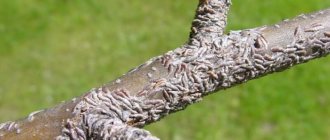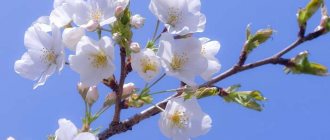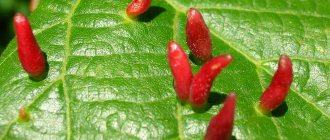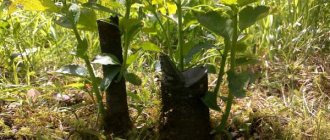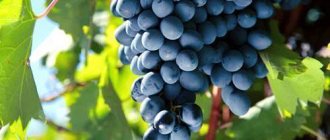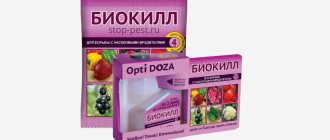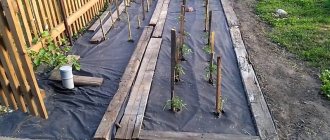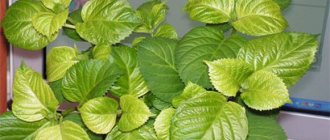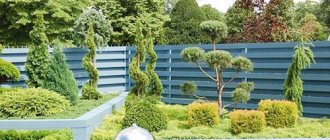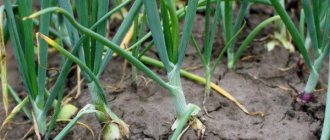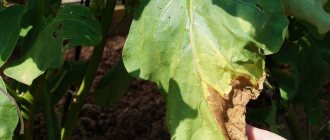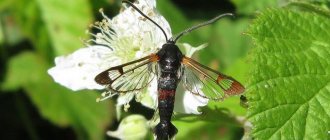Cherry coccomycosis is a fungal disease that affects all types of stone fruit trees. Experienced gardeners successfully fight this disease, but novice gardeners will need knowledge of control methods and frequency of treatments, as well as methods of prevention. You will find all this knowledge in our article.
The disease affects foliage, causing early leaf fall and weakening the protective functions of trees. The plant does not receive nutrition from the sun's rays and cannot prepare for winter. Scientists could not indicate with 100% certainty what type of pathogenic fungi is the causative agent of damage to stone fruit crops. The disease quickly spreads throughout the garden, affecting plants even in neighboring areas.
The main condition for the appearance of fungi is a humid climate with waves of evaporation from wet soil. Therefore, the gardener should check the cherries after rain or watering. Prolonged rainy weather is a period when massive damage to cherries and other types of stone fruits is possible. Failure to provide timely assistance causes loss of the crop and the entire plant.
Causes of coccomycosis
The main cause of coccomycosis in the garden:
- thickened crown;
- the surface of the trunk circle overgrown with weeds or young growth;
- the disease more easily affects trees with cracked bark and gum deposits;
- The main reason for plant damage by fungi is a warm and humid climate, with prolonged rains and winds. The wind carries pathogenic spores over long distances.
The “culprit” of the disease in cherries of the Uralskaya Rubinovaya, Shubinka, and Shubinka varieties, as well as others, is one of 2 harmful microorganisms:
- "Blumeriella jaapii" - the fungus has been known since the middle of the last century;
- A number of biologists consider the causative agent to be the fungus "Coccomyces hiemalis" , known to scientists since 1847.
Regardless of the type, the disease attacks plants unnoticed, quickly affecting the entire garden. An inexperienced gardener can only be surprised by the fall of leaves in August, but will not understand that the disease has begun to have a detrimental effect on the cherries.
Symptoms of the lesion
The disease occurs more often in Central Russia and in the Non-Black Earth Region. For the southern regions, in places with minimal rainfall, the possibility of fungi occurring is minimal. To combat, traditional medicine recipes or treatment with copper-containing preparations are used. In the south, it will be necessary to carry out preventive treatments by adding drugs to the pest control solution.
The fungus is resistant to low temperatures, even in the northern regions. Spores take refuge in fallen leaves, old fruits, as well as in cracks in bark and gum.
With the onset of a warm period, the wind carries the spores throughout the garden - this is how the spread and the next stage of the disease occurs.
The first symptom of the disease is the appearance of small spots with a white and red color on the foliage. Then the spots grow together into large areas, become brown or brown in color, and after 45-60 days, the affected leaves fall off the tree.
Moreover, part of the leaf may fall off or if the petioles are damaged, a period of early leaf fall begins. The fruits are also affected, they become deformed and become unfit for consumption. After wintering, in April - May, the first ripening of spores occurs, which are carried throughout the garden by wind and moisture evaporation. Therefore, the first signs appear on the lower part of the trees.
If tree treatment is started at the wrong time, it not only leads to loss of foliage and weakening of the tree, but also to a decrease in yield. The fruits ripen dried out, almost covered with a thin skin.
Treatment
It is important to begin operations to destroy spores of pathogenic fungi immediately at the first signs of damage to the tree. It is important for a gardener to choose the right variety that is resistant to coccomycosis and other fungi. Plants, even those with an increased level of resistance to the disease, can be attacked by spores over a long period of growth.
A weakened tree during rainy and warm periods is not able to resist pathogenic spores and pests. But these varieties of cherries reduce the risk and reduce the number of treatments of the garden with chemicals and traditional medicine solutions. As in the fight against other types of fungi, treatment of plants with copper or iron sulfate, as well as preventive whitewashing of trunks and the beginnings of skeletal branches with lime, helps to defeat the disease at an early stage. Find out about the medicinal properties of Indian onions in this article.
Copper sulfate solution.
Let us examine in detail each method of treating cherry trees affected by coccomycosis.
Chemicals
Here, treating plants with solutions of any fungicide better than copper-containing comes to the aid of gardeners. In a specialized store, summer residents will find many new and time-tested drugs. The main thing is to purchase a high-quality product and properly treat the plants with it.
The process of spraying foliage and the entire tree as a whole must be carried out with full responsibility, similar to when a sick person takes antibiotics. Chemicals must be diluted strictly according to the proportions indicated on the packaging. We present in a separate table the norms and rules for preparing solutions using basic chemicals.
| Name of chemical control agent. | The required proportion of the substance for dilution in 10 liters of water. | Maximum number of fungal control operations. | Minimum number of days before possible consumption of cherries. |
| Bordeaux mixture solution | Packaging with 100 ml of substance. | 3 | 28. |
| The drug "Abiga - Peak". | 40 g or one cap of a large bottle. | 4 | 20 |
| "Skor" | 2 ml. | 2 | 21 |
| "Horus." | 3.5 g. | 2 | 15 |
| "HOME." | 40 g. | 3 | 20 |
It is not recommended to use chemicals before harvesting cherries; the table shows waiting periods that must be strictly observed.
Many gardeners are against the use of chemicals in their garden and suggest using folk recipes. But only “Skor” or “Abiga-Pik” can quickly and reliably destroy pathogenic spores, especially in difficult cases. Traditional medicine helps only as a preventive measure or at an early stage of a tree disease.
Chemicals, although they require costs when purchased, will reliably destroy the disease at an early stage. And they will not allow the disputes to spread to neighboring stone fruit crops. To obtain an adult fruit-bearing tree, you will need to care for and process the seedling during the first 5 years after planting. According to calculations, the minimum level of costs for medications and other needs during this period will have to be paid by the gardener about 3 tons of rubles. But you will need to spend at least 6 thousand rubles per year to treat and fight the disease. Read how to treat cherries against worms and other insects here.
Carrying out preventive treatments of the garden is preferable to the costs of working to save garden stone fruit crops affected by coccomycosis.
Biological products and folk recipes
According to manufacturers of expensive biological control agents for fungal spores, this is a safe for humans, but effective method of combating coccomycosis. But adherents of chemical treatment argue that it is better to spray the garden with the simple and harmless preparation “Abiga-Pikom” than to use the expensive biological fungicide “Fitosporin”.
The biological product, when applied to the foliage, causes the growth of bacteria that feed on the spores of various fungi. The effect of the drug is absolutely harmless to humans; plants can be treated immediately before harvesting. “Fitosporin” is harmless to the plant itself, just like folk recipes. These preparations can be used to treat plants during the period of flowering and fruiting of stone fruits. This material will tell you about the characteristics and description of the Orange tomato variety.
Among the folk recipes, we highlight one effective composition:
- water – 5 l;
- sifted wood ash – 1 kg;
- laundry or tar soap – 30 g.
All ingredients are mixed, the solution is filtered and poured into the sprayer tank. It is recommended to use this solution weekly to treat problem gardens at the beginning of the warm period.
Regardless of the composition and type of drug, treatment is carried out only in the early morning or in cloudy weather. The solution is applied evenly to all surfaces of wood and foliage. Pay special attention to areas with cracked bark, gum drips, soil around the tree and the lower surfaces of foliage - these are places where fungi accumulate.
Agrotechnical methods
Agricultural technology for combating any fungi is the same. Required:
- constantly remove weeds and young growth under the crown of the cherry tree;
- in the fall, during leaf fall or when leaves fall early on a diseased tree, all leaves are taken out of the area and burned in a special barrel or disposed of in garbage containers;
- in the pre-winter period, all unpicked fruits are removed from the branches and disposed of in garbage containers;
- the soil in the tree trunk circle should be loose and mulched;
- to reduce evaporation, it is recommended to use a drip irrigation system;
- in late autumn, the soil under the bush is cleared of plant debris and dug up, and young trees are additionally covered with material or old roofing felt;
- all areas with emerging moss and places where cuttings are made are cleaned and covered with garden varnish.
Find out about planting and caring for Bessonovsky onions here.
Agrotechnical measures
Agrotechnical work complements chemical, biological and traditional methods of treatment:
- All affected areas of the cherries are cut out. There is no need to spare the tree; it is important to include healthy parts of the branches at 15-20 cm. The cutting tool used must be treated with an alcohol antiseptic after each cutting.
- The sections on which the old crown or moss was located are cleaned and generously lubricated with paint or garden varnish.
- Affected leaves, branches and fruits are burned as soon as possible. The fungus spreads rapidly and should not be left near healthy plants.
- Twice a year (in spring and autumn) the soil is irrigated with 4-6% urea.
- It is necessary to carry out work to loosen and mulch the soil around the cherries. The soil will be better saturated with oxygen, and the amount of evaporation will decrease. This will prevent the infection from spreading.
- You can normalize the level of soil moisture and reduce the risk of re-infection of the plant by resorting to drip irrigation.
- Work on the timely removal of weeds, moss and fallen leaves is mandatory, since they are a breeding ground for a pathogen that will spread despite the use of fungicides.
Related article:
How to recognize and defeat Verticella wilt
List of resistant varieties
The main way to reduce the risk of coccomycosis affecting cherries is to plant zoned varieties that are resistant to fungal diseases. First of all, this is a low-growing felt cherry; other options include:
- "Chocolate Girl"
- "Gurtievka".
- "Vocation".
- "Turgenevka".
- "Bulatnikovskaya".
- "Princess".
- "Black crust."
- "Fairy tale".
The list goes on, but before purchasing a seedling from a nursery, it is better to ask the manager about the best variety for your climate zone. These varieties may not be able to grow and bear fruit if they are not zoned for a particular climate.
How to recognize the disease
The fungal coccomycosis infection, which is considered relatively young, most often affects cherries and sweet cherries. At the end of spring, small red or brown spots appear on the leaf blades. They grow, turn into one big spot, then the leaves turn yellow and fall off. The seedlings grow poorly, lag behind in development, and stop bearing fruit.
If the pathogen infects the plant at a later date, the fruits also grow affected by the fungus. Spots appear on them, the berries acquire a watery structure, unpleasant taste and appearance.
Related article:
Folk remedies for aphids: vinegar, vodka, oil
Trees that are sick weaken and freeze in winter. If they remain infected for 2-3 years, they die.
Prevention
Preventative work in the garden will help prevent the disease and ensure normal growth and fruiting of cherries:
- after winter, when the soil begins to warm up, you will need to dig up the soil on the site, first removing all the leaves and remnants of dry grass;
- The main concern of the gardener is to constantly examine the foliage of the trees and carry out preventive treatments of the garden.
Frequency of spraying and pruning cherries
Gardens in which coccomycosis spores may appear will need to be constantly monitored and a series of treatments carried out according to the plan below:
- Early spring, before the buds begin to awaken - a control inspection, identifying branches damaged after winter and performing sanitary pruning of the cherry.
- The phase of the unopened bud (“green cone”) – treatment of the trunk circle and the entire tree with a solution of copper sulfate or “Abiga-Peak”. Application of nitrogen fertilizers.
Abiga-pik is an improved ordinary copper sulfate, produced in liquid form.
- Budding - treatment with a solution of any fungicide.
- 20-21 days after the end of flowering - inspect the cherries, pruning and removing damaged growths and branches from the area. Removing gum and treating areas with cracked bark with garden varnish. Spraying the plant with Skora solution. If spring is rainy, re-treatment with copper sulfate will be required.
- At the ripening stage , foliar feeding is added to the fungicide solution. To do this, you can use any ready-made fertilizer for this operation.
- The harvest is harvested and treated with a solution of Bordeaux mixture or a solution of soap and ash.
- In the pre-winter period - collecting and removing foliage, pruning damaged shoots, and treating cracked bark with gum deposits with garden varnish. Whitewashing the trunk and beginnings of skeletal branches with lime solution.
- Autumn digging of the soil and pre-winter watering of the tree with the application of potassium and phosphorus fertilizers.
- In early spring , pruning and shaping of the tree crown is performed, as well as the removal of affected branches.
This link will tell you about the description of the Radar onion variety.
Fighting methods
For successful treatment, it is necessary to follow the rules of agricultural technology. Fruits and branches affected by the fungus must be plucked off in a timely manner. Fully ripe fruits must be harvested on time. It is recommended to spray trees with special compounds.
A solution of iron sulfate copes well with coccomycosis. To do this, you need to take 300 g of the drug per 10 liters of water. A drug called Horus has also worked well. It is prepared at the rate of 2 g per 10 liters of water.
Cherry processing is carried out 20 days after the start of flowering. The second time it is necessary to spray 20 days after harvesting.
Advice: In early spring after the snow melts, it is recommended to treat with iron sulfate. The solution should be at a concentration of 60%.
It is recommended to spray cherry trunks. The solution will destroy pests overwintering in the tree bark.
